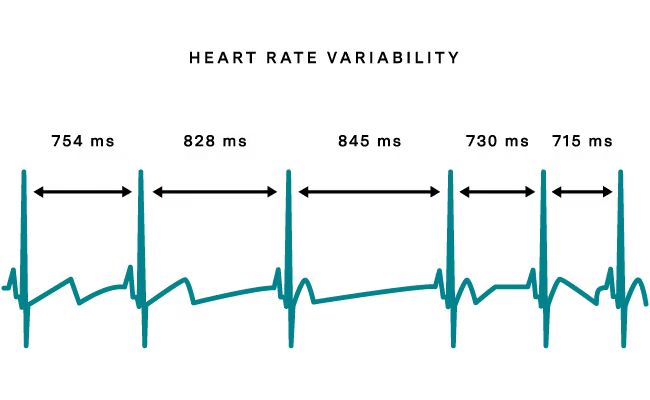
Key takeaways:
The intricate dance between our heart rate and brain function is more influential than we might think. Recent studies reveal that heart rate variability (HRV)—the measure of variations between individual heartbeats—affects our brain health, decision-making abilities, and even our emotional regulation. HRV is a physiological metric that we can train ourselves to improve, and its connections to the brain make HRV training a promising technique for dementia prevention and enhancing cognitive function.
Understanding the Heart-Brain Connection:
While your heart rate is the average number of beats per minute, HRV is the difference in length between individual heartbeats.

HRV is not just a measure of heart health - it reflects the health and balance of the autonomic nervous system (ANS), which is responsible for involuntary body functions. In particular, HRV serves as a key indicator of the interaction between the two components of the ANS: the sympathetic (fight or flight) and parasympathetic (rest and digest) nervous systems. Interestingly, there is a two-way feedback system between these nervous systems and the heart. The signals from the sympathetic and parasympathetic influence heart rate, and heart rate regulates the balance of these two systems. By exerting an influence on the ANS, heart rate variability helps regulate emotions and stress responses. In general, higher HRV is associated with better control over decision-making processes, emotional responses, anxiety, and social behaviors1.
Booting your HRV
Common HRV training protocols call for biofeedback, which is a fancy way of saying you need a sensor to measure your heart rate variability so you can improve it. HRV training involves guided exercises such as paced breathing while looking at real-time heart rate data to learn to consciously control heart rate variability. This is what makes it different from techniques like yoga or meditation - their focus is commonly to achieve a balanced state, whereas the goal of HRV training is to modulate physiological responses.
This technique not only promotes a balanced state but also has long-lasting effects on both mental and physical health. Thanks to the heart-brain connection, HRV training leads to improved emotional regulation and stress management. Although different training regimens exist, just five minutes of HRV training twice a day can significantly enhance control over the heart and reduce anxiety levels during stressful periods2. Critically, the benefits of HRV training extend far beyond mood and feeling: they also correlate with enhanced executive functions like planning, problem-solving, and resisting unhealthy impulses1. In fact, the benefits of this training can persist, with improvements seen even 12 weeks after stopping the training1.
Tying back to dementia
Thanks to its influence on stress response, cognitive function, healthy behaviors, and cardiac health, it’s no surprise that higher HRV is associated with stronger resilience against cognitive decline2,3. Since the simple daily practice of HRV biofeedback training can improve your HRV, we can think of it as a valuable tool to help delay the onset and progression of dementia. It's a clear testament to the power of our bodies' interconnected systems, and a reminder that taking care of our heart is as much about our mind.
Where to start with HRV training
- Choose a tracking device: the first step is to make sure you have the right equipment to measure your heart rate variability. Because you are measuring the time between individual heartbeats, you need a particularly sensitive device. Although some common wearables like the Apple watch or Whoop claim to measure HRV, it’s better to opt for a specialized chest strap like the Polar H10 which can connect to your other wearables.
- Visualize your data: once you have a solid device, use an app like Elite HRV or Welltory (both of which have a free version available) so that you can visualize your HRV in real time. These apps also come with a wealth of additional insights that can help you fine tune your training.
- Start training: you can find guided training sessions either through apps like Elite HRV or through online courses provided by organizations like the HeartMath Institute. YouTube also has a number of guided HRV routines you can try, such as this one from the Huberman Lab show.
- Learn more: The Peter Attia Drive podcast has an episode that dives deep into HRV so you can learn more about how it works and how it can help you.

